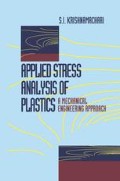Abstract
One of the evolutionary changes in the plastics industry is the shift from the concept of “design-by-rules” to one of “design-by-analysis.” Design-by-rules is the method of design based on prior experience, rather than by structural mechanics. In design-by-analysis, stress analysis plays a central role [1]. It is not a new concept in mechanical engineering, since such a concept arose in railroad engineering, and then was adopted in automotive, and aircraft industries, and later in the nuclear power industry with higher levels of sophistication. In its simplest form, the concept emphasizes the thorough understanding of the in-service behavior of a product well before its manufacture. Simply, the design-and-analysis technique is the most economical way to simulate the working of the product, before its blueprints are made. The concept of design-by-analysis is already in vogue in mature industries. With the increasing use of plastics for structural functions, the relevance of design-by-analysis is evident. Thanks to powerful personal computers, the engineer is able to perform several tasks of design-by-analysis at a reasonable cost. Typically, the geometry of a part is created with CAD software and is data-based in a format that can be ported to many different software modules. For example, it can be used as input for a mold flow analysis, a mold design program, a material estimation program, a drafting program, or a finite element analysis program. Until the late 1980s, such facilities were out of the reach of any but the very largest industries.
Access this chapter
Tax calculation will be finalised at checkout
Purchases are for personal use only
Preview
Unable to display preview. Download preview PDF.
References
Bernstein, M. D., Design Criteria for Boilers and Pressure Vessels in the U.S.A., in ASME PVP-Vol. 162, 1988 International Design Criteria of Boilers and Pressure Vessels, 1988, ASME.
ANSI Z-90.1971, Am. Natl. Std.,Specifications for Protective Headgear for Vehicular Users (High Protection).
ANSI Z-89.1981, Am. Natl. Std.,Requirements for Protective Headwear for Industrial Workers.
SAE Handbook, Vol. 4, Specification No. SAE-J980a, Bumper Evaluation Test Procedure—Passenger Cars, published by Soc. of Automotive Engineers, Warrendale, PA.
AWWA Standard No. C950–88, 1988, Standard for Fiberglass Pressure Pipe, published by American Water Works Association, Denver, CO.
Modern Plastics Encyclopedia, 1984, Vol. 61, Number 10A, McGraw Hill, New York, NY.
Laminate Analysis Program, In-house software, L. J. Broutman and Associates, Chicago, IL.
Metals Handbook, Vol. 1, Properties and Selection, Irons and Steels, and Vol. 2, Properties and Selection, Nonferrous Alloys and Pure Metals, American Society for Metals, Metals Park, OH.
Manual of Steel Construction Allowable Stress Design, 9th Edn, Published by Amer. Inst of Steel Construction, Chicago, IL.
Bathe, K. J. Finite Element Procedures in Engineering Analysis, 1982, Prentice-Hall, Englewood Cliffs, NJ.
Cook, R. D., Malkus, D. S., and Plesha, M. E., Concepts and Applications of Finite Element Analysis, 1989, 3rd Edn., John Wiley & Sons, New York, NY.
Beer, F. P. and Johnston, E. R. Jr., Mechanics of Materials, 1981, McGraw Hill, New York, N.Y.
Gere, J. M. and Timoshenko, S. P., Mechanics of Materials, 1984, PWS Publishers, Boston, MA.
Kroencke, W. C., Classification of Finite Element Stresses According to ASME Section III Stress Categories, Pressure Vessel and Piping, Analysis and Computer, ASME June 1974.
Kroencke, W. C., Addicott, G. W., and Hinton, B. M., Interpretation of Finite Element Stresses According to ASME Section III ASME Paper No. 75-pvp-63, ASME Second National Congress on Pressure Vessels and Piping, June 1975.
Roark, R. J. and Young, W. C., Formulas for Stress and Strain, 5th Edn., 1975, McGraw Hill, New York, N.Y.
Peterson, R. E., Stress Concentration Design Factors, 1953, John Wiley & Sons, Inc., New York, N.Y.
Timoshenko, S. P. and Goodier, J. N., Theory of Elasticity, 3rd Edn., 1970, McGraw Hill, New York, N.Y.
Harvey, J. F., Theory and Design of Modem Pressure Vessels, 2nd Edn., 1974, Van Nostrand Reinhold, New York NY.
Author information
Authors and Affiliations
Rights and permissions
Copyright information
© 1993 Springer Science+Business Media New York
About this chapter
Cite this chapter
Krishnamachari, S.I. (1993). Rationale of Stress Analysis. In: Applied Stress Analysis of Plastics. Springer, Boston, MA. https://doi.org/10.1007/978-1-4615-3110-4_4
Download citation
DOI: https://doi.org/10.1007/978-1-4615-3110-4_4
Publisher Name: Springer, Boston, MA
Print ISBN: 978-0-442-23907-7
Online ISBN: 978-1-4615-3110-4
eBook Packages: Springer Book Archive

